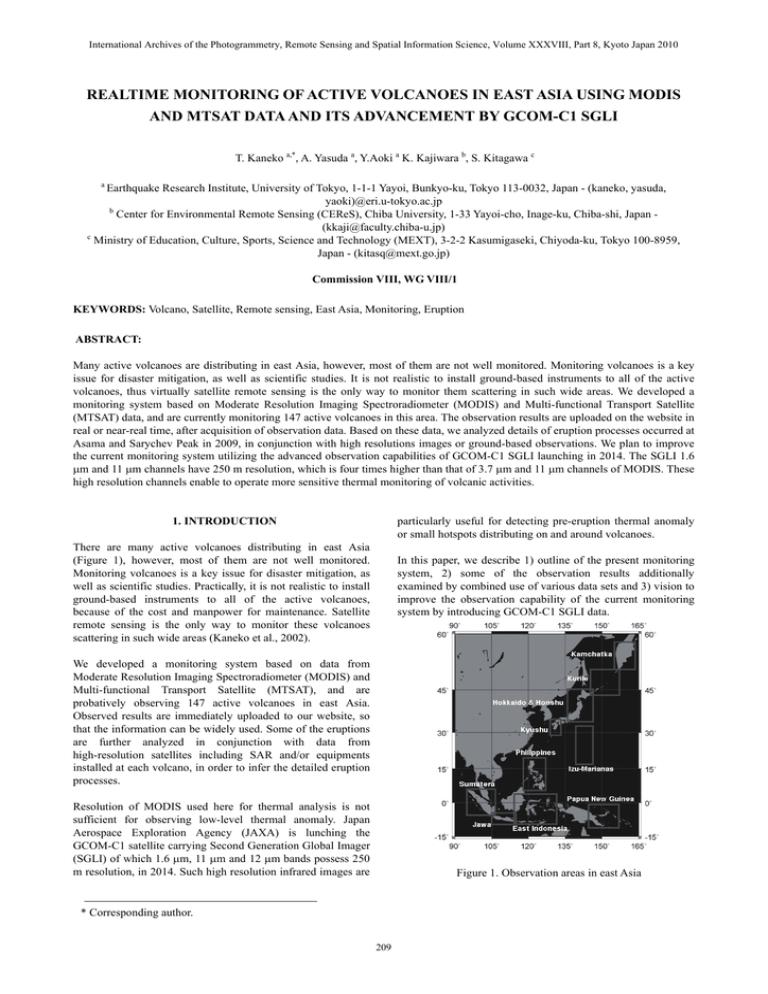REALTIME MONITORING OF ACTIVE VOLCANOES IN EAST ASIA USING MODIS
advertisement

International Archives of the Photogrammetry, Remote Sensing and Spatial Information Science, Volume XXXVIII, Part 8, Kyoto Japan 2010 REALTIME MONITORING OF ACTIVE VOLCANOES IN EAST ASIA USING MODIS AND MTSAT DATA AND ITS ADVANCEMENT BY GCOM-C1 SGLI T. Kaneko a,*, A. Yasuda a, Y.Aoki a K. Kajiwara b, S. Kitagawa c a Earthquake Research Institute, University of Tokyo, 1-1-1 Yayoi, Bunkyo-ku, Tokyo 113-0032, Japan - (kaneko, yasuda, yaoki)@eri.u-tokyo.ac.jp b Center for Environmental Remote Sensing (CEReS), Chiba University, 1-33 Yayoi-cho, Inage-ku, Chiba-shi, Japan (kkaji@faculty.chiba-u.jp) c Ministry of Education, Culture, Sports, Science and Technology (MEXT), 3-2-2 Kasumigaseki, Chiyoda-ku, Tokyo 100-8959, Japan - (kitasq@mext.go.jp) Commission VIII, WG VIII/1 KEYWORDS: Volcano, Satellite, Remote sensing, East Asia, Monitoring, Eruption ABSTRACT: Many active volcanoes are distributing in east Asia, however, most of them are not well monitored. Monitoring volcanoes is a key issue for disaster mitigation, as well as scientific studies. It is not realistic to install ground-based instruments to all of the active volcanoes, thus virtually satellite remote sensing is the only way to monitor them scattering in such wide areas. We developed a monitoring system based on Moderate Resolution Imaging Spectroradiometer (MODIS) and Multi-functional Transport Satellite (MTSAT) data, and are currently monitoring 147 active volcanoes in this area. The observation results are uploaded on the website in real or near-real time, after acquisition of observation data. Based on these data, we analyzed details of eruption processes occurred at Asama and Sarychev Peak in 2009, in conjunction with high resolutions images or ground-based observations. We plan to improve the current monitoring system utilizing the advanced observation capabilities of GCOM-C1 SGLI launching in 2014. The SGLI 1.6 μm and 11 μm channels have 250 m resolution, which is four times higher than that of 3.7 μm and 11 μm channels of MODIS. These high resolution channels enable to operate more sensitive thermal monitoring of volcanic activities. 1. INTRODUCTION particularly useful for detecting pre-eruption thermal anomaly or small hotspots distributing on and around volcanoes. There are many active volcanoes distributing in east Asia (Figure 1), however, most of them are not well monitored. Monitoring volcanoes is a key issue for disaster mitigation, as well as scientific studies. Practically, it is not realistic to install ground-based instruments to all of the active volcanoes, because of the cost and manpower for maintenance. Satellite remote sensing is the only way to monitor these volcanoes scattering in such wide areas (Kaneko et al., 2002). In this paper, we describe 1) outline of the present monitoring system, 2) some of the observation results additionally examined by combined use of various data sets and 3) vision to improve the observation capability of the current monitoring system by introducing GCOM-C1 SGLI data. We developed a monitoring system based on data from Moderate Resolution Imaging Spectroradiometer (MODIS) and Multi-functional Transport Satellite (MTSAT), and are probatively observing 147 active volcanoes in east Asia. Observed results are immediately uploaded to our website, so that the information can be widely used. Some of the eruptions are further analyzed in conjunction with data from high-resolution satellites including SAR and/or equipments installed at each volcano, in order to infer the detailed eruption processes. Resolution of MODIS used here for thermal analysis is not sufficient for observing low-level thermal anomaly. Japan Aerospace Exploration Agency (JAXA) is lunching the GCOM-C1 satellite carrying Second Generation Global Imager (SGLI) of which 1.6 μm, 11 μm and 12 μm bands possess 250 m resolution, in 2014. Such high resolution infrared images are Figure 1. Observation areas in east Asia * Corresponding author. 209 International Archives of the Photogrammetry, Remote Sensing and Spatial Information Science, Volume XXXVIII, Part 8, Kyoto Japan 2010 3.1 Volcanoes of which eruptions were detected by the satellite system in 2009 2. OUTLINE OF THE OBSERVATION AND DATA PROCESSING SYSTEM 2.1 Satellite System The monitoring system we developed is based on MODIS and MTSAT (Figure 2). On the basis of differences in resolution and observation cycle, MODIS is mainly used for monitoring level of activity and detecting pre-eruption anomaly with a time-series variation of thermal anomaly, while MTSAT is for detecting eruption events, thanks to the high observation cycle every 30-60 minutes. MODIS data are obtained from NASA and Institute of Industrial Sciences, University of Tokyo. MTSAT data are directly downlinked to the receiving station at our institute in Tokyo. Currently we are monitoring 147 active volcanoes in east Asia - Kamchatka Peninsula, Kuril Islands, Japanese Islands, Izu-Mariana arc, Philippines, Indonesia and Papua New Guinea (Figure 1). MTSAT is a gestational meteorological satellite of Japan Meteorological Agency and Civil Aviation Bureau and has five observation channels in the visible to infrared regions (visible:1 and infrared:4). Although the resolution is low (1 km in visible and 4 km in infrared), the observation cycle is very high, which is preferable for studies of eruption clouds. Figure 3. Volcanoes detected thermal anomaly in 2009 In 2009, eruptions were detected in the volcanoes shown in Figure 3. Among them, we analyzed details of eruptions occurred at Asama, Japan and Sarychev Peak, in Kuril islands, in conjunction with field observations and high-resolution satellite images. MODIS is a sensor onboard the Terra and Aqua satellites, circling the earth on a polar orbit. Terra MODIS and Aqua MODIS are observing the entire Earth's surface every 1~2 days with a viewing swath width of 2,330 km. It has 36 spectral bands between 0.405µm and 14.385 µm, and acquires data at resolutions of 250m, 500m and 1 km. In our monitoring system, band 21 (3.929 - 3.989 µm / 1 km) is used for detecting thermal anomalies on volcanoes and band 31 (10.780 µm - 11.280µm / 1 km) is for inferring the background temperature of the ground. Figure 4. Brightness temperature difference (ΔΤ Κ) images between two thermal infrared channels (10.3-11.3 μm and 11.5-12.5 μm) of MTSAT. (a) 2:30 am (JST), (b) 3:30 am, (c) 4:30 am, (d) 5:30 am Figure 2. Outline of the observation system 3.2 Observation and analysis of the Eruption Cloud from the Asama 2009 Eruption 2.2 Web System The observation results are uploaded on the website (http://vrsserv.eri.u-tokyo.ac.jp/REALVOLC/) within a several hours for MTSAT and several days for MODIS after data acquisition at each volcano. This web system consists of four sub-systems MODIS-infrared, MODIS-visible, MTSAT-infrared and MTSAT-visible. Mt. Asama, located in central part of Japan, erupted on 2nd February 2009, following the eruptions occurred in 2004 (Kaneko et al., 2004). The 2009 event was a small-scale eruption, involving a eruption plume rising 2000 m high from the summit, however, the ashes accidentally fell in the Tokyo, because of strong seasonal wind. 3. OBSERVATION RESULTS We observed migration processes of the eruption cloud, using infrared images of MTSAT, and analyzed its relationship to 210 International Archives of the Photogrammetry, Remote Sensing and Spatial Information Science, Volume XXXVIII, Part 8, Kyoto Japan 2010 distribution of ash-fall deposits and meteorological conditions. Four MTSAT images taken on 2nd February at 2:30 am, 3:30 am, 4:30 am and 5:30 am were used for the analysis. Images of brightness-temperature difference between two thermal infrared channels (10.3-11.3 μm and 11.5-12.5 μm) were used for identifying distribution of the eruption cloud. The results indicate that the eruption cloud migrated to the southeast along the line connecting between Mt. Asama and Katsuura-city on the Boso peninsula through the central part of Tokyo (Figure 5). The eruption cloud elongated toward the direction of the migration and the total length increased with time. The speed of the eruption cloud was inferred to be 135 km/h at the top and 51 km/h at the tail, respectively. This relative speed difference could cause elongation of the total length. According to the meteorological data, at the altitude of 4900-5700 m, wind was blowing to the southeast at the speed of 119 km/h, and at 2700-3100 m to the same direction at 50 km/h. These values coincided with the inferred speed of the head and tail, respectively, which indicates the difference in the wind speed was the main cause of the elongation (Figure 6). Distribution area of the ash-fall deposits on the ground did not well much the area where the eruption cloud flew over, but was located 0-40 km south of it (Figure 5). Unlike the higher altitude, in the regions lower than ~2000m, wind was roughly blowing to the south at somewhat lower speed. When falling ashes from the eruption cloud entered this region, they could be blown to the further south, which could cause the wide and biased distribution of the ash-fall deposits, as shown in Figure 6 (lower). Figure 6. Schematic illustration of migration processes of the eruption cloud exposing on the southwestern part. Lava flows flowed down all sides of the edifice. Eruptions have been recorded since the 1760's and include both lava effusion and explosions. One of the largest historical eruptions of Sarychev Peak in 1946 (VEI=4) produced pyroclastic flows that reached the sea. The latest eruption before 2009 occurred in 1989. (a) (b) Figure 5. Migration and elongation of the eruption cloud as detected by MTSAT images. Dotted lines show the distribution limit of the ash-fall deposits (JMA). Solid line indicates the depositional axis of the ash-fall deposits (extrapolation from the distribution at the southeastern foot of the volcano) (c) Figure 7. (a) Umbrella clouds generated by Plinian eruptions observed by MTSAT (visible). (b) Time-series variation of thermal anomaly observed by MODIS. (3) Eruption sequence and height of eruption plumes On 11th June 2009, Sarychev Peak volcano erupted. Based on MTSAT data, Plinian eruptions were observed to repeatedly 3.3 Observation and analysis of the 2009 Eruption at Sarychev Peak volcano Sarychev Peak is one of the most active volcanoes of the Kuril Islands, on Matua Island in the central Kuriles (Gorshkov, 1970). The central cone was constructed within a caldera 211 International Archives of the Photogrammetry, Remote Sensing and Spatial Information Science, Volume XXXVIII, Part 8, Kyoto Japan 2010 occur 1-5 times a day between 11th and 16th, of which umbrella clouds had a diameter of several tens to one hundred kilometers (Figure 7a). Height of these eruption plumes were estimated to be 10-11 km, based on surface temperature of the umbrella clouds (Figure 7c). After the last Plinian eruption, on the morning of 16th, the eruption state had changed into a moderate one where a continues plume was emitted from the summit, which lasted at least until 20th of February. SGLI also has advantages in the realtime capability - the data are planned to be processed and stored in the server within several hours after acquisition for east Asia. This will dramatically improve time lag between acquisition of data at each volcano and transmission of information from the system, currently restricted by the data system of MODIS. Use of GCOM-C1 SGLI will move the satellite-based monitoring system forward to a operational level for volcano monitoring. Thermal anomaly observed by MODIS showed an abrupt high peak on 12th-14th and drastically decreased in synchronously with lowering of eruptive activity as observed by MTSAT (Figure 7b). No pre-eruption thermal anomaly was recognized. Photo-interpretation of high resolution images from ALOS AVNIR-2 and ASTER taken before and after the main eruptive phase, showed that the northwestern half of the edifice was totally covered by the pyroclastic-flow deposits generated by the repeated Plinian eruptions (Figure 8). The deposits on the slope flowed down at several areas along the gullies as debris flows, which formed many river-mouth deltas on the coastal areas. In the last stage of the activity, two lava flows effused from the flank vents near the summit and flowed down toward the northeast and the northwest on the slope. Figure 9 Schematic illustration of the observation system involving GCOM-C1 SGLI Figure 8. Distribution of the 2009 deposits REFERENCES Gorshkov, G. S., 1970. Volcanism and the Upper Mantle; Investigations in the Kurile Island Arc. Plenum Publishing Corp, New York, 385 pp. Kaneko, T., Takasaki, K., Yasuda, A. and Aoki, Y. 2006. Thermal surveillance of the Asama 2004-2005 activity using MODIS nighttime infrared images, Bull. Volcanol. Soc. Japan, 51(4), 273-282. Kaneko,T., Yasuda, A., Ishimaru,T., Takagi,M., Wooster, M.J., and Kagiyama, T. 2002. Satellite Hot Spot Monitoring of Japanese Volcanoes: A Prototype AVHRR-based System. Advances in Environmental Monitoring and Modelling, 1(1), pp.125-133. ACKNOWLEDGEMENTS We thank Y. Honda (Chiba University) and H. Murakami (EORC/JAXA) for constructive suggestions and support, and H. Den (ERI, University of Tokyo) and K. Takasaki (SFC, Keio University) for developing and operating the monitoring system. This project was supported by a Grant-in-Aid for Scientific Research for TK (No. 18201034) from the Ministry of Education, Culture, Sports, Science and Technology (MEXT), Japan and Global Change Observation Mission: Second Research Announcement (SGLI on GCOM-C1) from Earth Observation Research Center, Japan Aerospace Exploration Agency (EORC/JAXA). determined by ALOS AVNIR-2 and ASTER images 4. ADVANCEMENT BY GCOM-C1 SGLI We plan to improve the current monitoring system utilizing the advanced observation capability of GCOM-C1 SGLI, which is scheduled to launch in 2014. The 1.6 μm and 11 μm channels of SGLI have 250 m resolution (11μm optional), which is four times higher than that of 3.7 μm and 11 μm channels of MODIS adopted in the current monitoring system (Figure 9). These high resolution channels enable to operate more sensitive thermal monitoring of volcanic activities, which is especially useful for 1) detecting pre-eruption thermal anomalies in the very early stage of activity, and 2) detecting and monitoring small scale eruptions. 212







